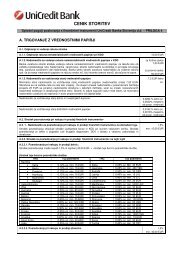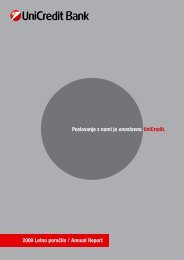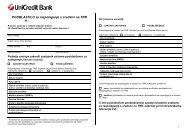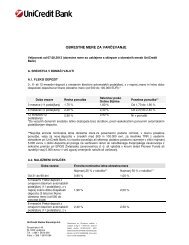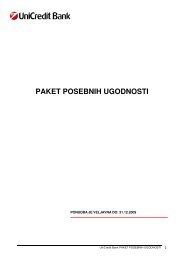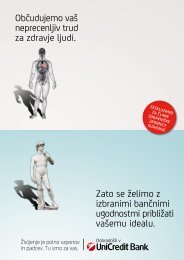Economics Research The UniCredit Weekly Focus
Economics Research The UniCredit Weekly Focus
Economics Research The UniCredit Weekly Focus
You also want an ePaper? Increase the reach of your titles
YUMPU automatically turns print PDFs into web optimized ePapers that Google loves.
26 September 2013 <strong>Economics</strong> & FI/FX <strong>Research</strong><strong>Weekly</strong> <strong>Focus</strong>Chart 5 shows that capacity utilization and the yoy change in capex tend to move in synch,especially since 2005: therefore, the former (which is more timely available) provides valuableinformation to track the capex cycle and spot its turning points. But a simple graphical inspectiondoes not tell the whole story. We want to dig further into the relationship between capacityutilization and capex, and as a first step we estimate the level of the utilization rate whichtriggers capex expansion plans by firms. Our regression puts this threshold at around 80%.As a second step, we investigate whether capex reacts only to the level of capacity utilization,or also to its change. Accordingly, we augment the previous model with a term which measuresthe change in capacity utilization, i.e. a momentum term. <strong>The</strong> results are interesting:in the augmented model, the momentum term is more significant than the level term, and thesignificance of the latter even slightly increases with respect to the level-only model of the firststep. This suggests that when firms plan their investment decisions, they look at both thechange and the level of capacity utilization, and assess these two variables separately. Whilethe level of capacity utilization is a rather intuitive driver of capex – firms start to invest onlywhen utilization rates climb above a certain threshold, in our model 80% – the very strongsignificance of the momentum term is less obvious. We think it may be related to the fact thatcapacity utilization is characterized by high persistency: this provides turning points in theutilization rate with an important signaling effect, which induces firms to change their capexplans in anticipation of the new trend before the critical 80% threshold is hit.<strong>The</strong> main practical implication of these findings is that the current low level of capacity utilizationis not at all inconsistent with the beginning of a capex recovery, provided that the upwardtrend in the utilization rate will not be reversed. As a matter of fact, our simple frameworkcorrectly predicted the modest improvement in capital expenditure recorded in 2Q13.Profitability: Corporate profitability is among the key determinants of capex. This can beseen from the tight correlation between the gross operating surplus – the national accountequivalent of EBITDA – and capex (see chart 6). In turn, profitability moves in tandem withlabor productivity, as shown in chart 7 next page. After the prolonged deceleration in thegrowth rate of productivity that began in the spring of 2011, the tide has now started to turn. In 1H13,labor productivity posted two consecutive qoq increases, and qualitative indications comingfrom business surveys show that the trend continued in 3Q13. For example, the rising gapbetween the output and the employment index of the Composite PMI suggests an acceleration inthe pace of improvement of productivity (see chart 8 next page).Given that a number of countries witnessed labor hoarding and a corresponding worsening ofprofitability during the downturn, it is likely that the economic recovery will remain a joblessone for some time. This appears to be a necessary development, which will allow firms tore-build profit margins and, hence, put the investment recovery on stronger foundations.CHART 5: CAPEX AND CAPACITY UTILIZATION HAND IN HANDCHART 6: PROFITABILITY IS A KEY DRIVER OF CAPEX871510158510810838179506425077-50-575-10-2-107371Capacity Utilization (%) - LS69Capex (% yoy) - RS671Q 96 4Q 98 3Q 01 2Q 04 1Q 07 4Q 09 3Q 12-15-20-25-4-6Gross Operating Surplus (% yoy) - LS-8Capex (% yoy) - RS-101Q96 4Q98 3Q01 2Q04 1Q07 4Q09 3Q12-15-20-25Source: EC, Eurostat, Thomson Datastream, <strong>UniCredit</strong> <strong>Research</strong><strong>UniCredit</strong> <strong>Research</strong> page 7 See last pages for disclaimer.



